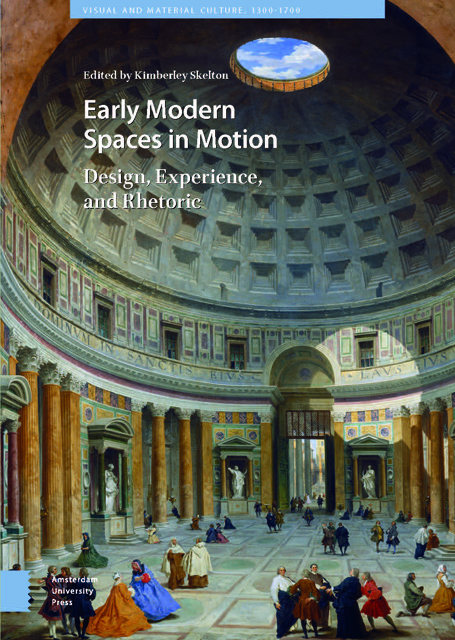Book contents
- Frontmatter
- Table of Contents
- List of Illustrations
- Acknowledgements
- Introduction: Bodies and Buildings in Motion
- 1 Navigating the Palace Underworld : Recreational Space, Pleasure, and Release at the Castello del Buonconsiglio, Trent
- 2 Passages to Fantasy : The Performance of Motion in Celliniâs Fontainebleau Portal and the Galerie François I
- 3 The Catholic Country House in Early Modern England : Motion, Pietyand Hospitality, c. 1580â1640
- 4 Sensory Vibrations and Social Reform at San Michele a Ripa in Rome
- 5 The Rise of the Staircase: Motion in Eighteenth-Century Dutch Domestic Architecture
- 6 Movement through Ruins: Re-experiencing Ancient Baalbek with Jean de la Roque
- 7 A Paper Tour of the Metropolis : The Architecture of Early Modern London in the Royal Magazine
- 8 Libraries in Motion: Forms of Movement in the Early Modern Library (1450-1770)
- Works Cited
- Index
7 - A Paper Tour of the Metropolis : The Architecture of Early Modern London in the Royal Magazine
Published online by Cambridge University Press: 11 January 2023
- Frontmatter
- Table of Contents
- List of Illustrations
- Acknowledgements
- Introduction: Bodies and Buildings in Motion
- 1 Navigating the Palace Underworld : Recreational Space, Pleasure, and Release at the Castello del Buonconsiglio, Trent
- 2 Passages to Fantasy : The Performance of Motion in Celliniâs Fontainebleau Portal and the Galerie François I
- 3 The Catholic Country House in Early Modern England : Motion, Pietyand Hospitality, c. 1580â1640
- 4 Sensory Vibrations and Social Reform at San Michele a Ripa in Rome
- 5 The Rise of the Staircase: Motion in Eighteenth-Century Dutch Domestic Architecture
- 6 Movement through Ruins: Re-experiencing Ancient Baalbek with Jean de la Roque
- 7 A Paper Tour of the Metropolis : The Architecture of Early Modern London in the Royal Magazine
- 8 Libraries in Motion: Forms of Movement in the Early Modern Library (1450-1770)
- Works Cited
- Index
Summary
Abstract
In the middle of the eighteenth century, as the magazine trade in Britain became increasingly competitive, publications began offering their readers illustrations. Beginning in 1761, The Royal Magazine published several illustrations of buildings in London as part of ‘A Tour through the Cities of London and Westminster’. Many of these illustrations represented London buildings through perspective views, often with urban spectators shown looking at them, as if they were in the middle of their own tour of the city’s architecture. This essay explores how this series of illustrations formed a virtual tour of London’s most notable buildings, making the capital’s architecture available in a highly accessible form, as if people could move through the city while moving through the pages.
Keywords: magazine illustrations, tourism, architectural illustrations, eighteenthcentury magazines
Mid-eighteenth-century London was a city of grand buildings. Several buildings, including St. Paul’s Cathedral, the Royal Exchange, and numerous city churches, had been rebuilt in the aftermath of the Great Fire of 1666; others, such as the Custom House (completed 1725), the Lord Mayor’s Mansion (completed 1753), and St. Bartholomew’s Hospital (completed 1769), were more recent projects. These buildings were transformative for London’s urban spaces, but they were also transformative for the idea of the city. Representations of individual London buildings were critical to representations of the city as a whole and, by extension, to civic identity. Although images of London buildings had been functioning in this way for decades, in the mid-eighteenth century a new form of image emerged: the magazine illustration. Many eighteenth-century magazines occasionally depicted notable buildings in London, both historic and contemporary, in elevations, plans, or fold-out views, but one of the richest examples of architectural magazine imagery is a series that appeared in the Royal Magazine in the early 1760s. The scale of this series was unusual, and the style of its images was distinctive. This essay will examine the Royal’s series of illustrations as critical imagery in a virtual tour of London’s notable buildings, a tour that made the city’s architecture available in a highly accessible form to people throughout Britain and in British colonies overseas. London was a tourist destination, and thus its most prominent buildings had long-established roles as sites of spectatorship, but the magazine offered a new form of virtual tourism.
- Type
- Chapter
- Information
- Early Modern Spaces in MotionDesign, Experience and Rhetoric, pp. 189 - 210Publisher: Amsterdam University PressPrint publication year: 2020



